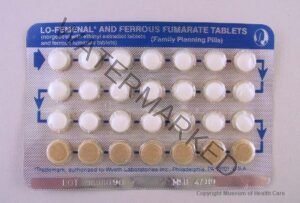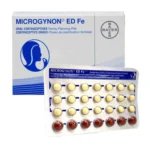Reproductive Health
Hormonal Methods of Family Planning
Table of Contents

Hormonal family planning methods use hormones to prevent pregnancy. These methods rely on synthetic hormones, similar to those naturally produced in the body, to manage a woman’s monthly cycle and primarily stop ovulation. Ovulation is the process where an ovary releases an egg. By preventing this egg release, hormonal contraceptives significantly reduce the chance of sperm fertilizing an egg, thereby preventing pregnancy.
These include;
Oral contraceptive pills
Implants
Injectable contraceptive
Emergency contraceptive pills
Oral Contraceptive Pills
i) Progesterone Only Pills (POP)
Examples include:
- Ovrette
- microval

They are formulated with the hormone progesterone.
These pills are often recommended for mothers who are breastfeeding because they are designed not to interfere with or reduce milk production.
Modes of Action
The primary way they work is by increasing the thickness and viscosity of the cervical mucus. This thickened mucus acts as a barrier, making it more difficult for sperm to travel through the cervix and reach an egg.
Additionally, POPs can cause changes to the endometrium, the lining of the uterus, making it less receptive to implantation of a fertilized egg (blastocyst).
While ovulation is usually prevented by combined pills, Progesterone Only Pills sometimes prevent ovulation. Ovulation is suppressed in a smaller percentage of users, estimated to be around 2%. It’s important to note that approximately half of women taking POPs continue to ovulate.
Advantages
Highly effective at preventing pregnancy when taken consistently and correctly.
Generally associated with fewer estrogen-related side effects compared to combined pills.
Offers protection against unintended pregnancy.
Suitable for breastfeeding mothers as they typically do not negatively impact milk supply.
May help lessen the severity of menstrual cramps for some individuals.
May contribute to improved iron levels, potentially aiding in preventing or managing anemia in some cases.
Offers some protection against ectopic pregnancy (pregnancy outside the uterus).
Contraindications
Established or suspected pregnancy.
Unexplained vaginal bleeding that has not been evaluated by a healthcare provider.
Current or recent history of breast cancer.
Certain arterial diseases.
History of or current thromboembolic disorders (conditions involving blood clots).
Active liver diseases.
Uncontrolled high blood pressure (hypertension).
Side Effects
Absence of menstruation (amenorrhea) in some users.
Spotting or light bleeding between periods.
Changes in menstrual bleeding patterns, including prolonged or heavier bleeding.
Lower abdominal discomfort or pain.
Fluctuations in weight, including either weight gain or weight loss.
Jaundice (yellowing of the skin and eyes).
Nausea and vomiting.
Headache, particularly if accompanied by blurred vision.
Increased growth of body hair (excessive hair growth).
Breast tenderness or a feeling of fullness in the breasts.
Elevated blood pressure.
Combined Oral Contraceptive Pills (COC)
These pills are formulations that contain a combination of both estrogen and progesterone hormones. They are designed to provide the combined effects of both hormones for contraception.
Estrogen component primarily functions to prevent ovulation. The progesterone component works by creating an environment less favorable for egg transport and by thickening the cervical mucus. This thickened mucus hinders sperm from entering the cervical canal and moving towards the egg.
Examples include:
- Lo-femenal
- Pillplan (duofen)
- Microgynon



Advantages
Extremely effective method of contraception (approaching 99% efficacy) when used correctly.
Provides reliable protection against unintended pregnancies.
User-friendly method that is taken orally, is easy to administer, and does not interrupt sexual activity.
Can be beneficial in regulating irregular menstrual cycles, making periods more predictable.
Associated with a significant reduction (approximately 50%) in the risk of developing both ovarian and endometrial cancers over time.
Can alleviate menstrual cramps, making periods less painful for some individuals.
Typically, a pelvic examination is not a mandatory requirement before initiating use, simplifying access.
Generally have a profile of manageable side effects for many users.
Fertility returns relatively quickly once the pills are discontinued, allowing for family planning flexibility.
Disadvantages
Refer to the disadvantages listed for Progesterone Only Pills (POP) as some side effects may overlap.
Side Effects
Discomfort or pain in the chest area.
Absence of menstrual periods (amenorrhea).
Breakthrough bleeding or spotting between scheduled periods.
Elevation in blood pressure readings (hypertension).
Feelings of sickness, lightheadedness, and increased anxiety or agitation.
Development or worsening of acne.
Increased size and sensitivity of breasts.
Mood changes, including feelings of sadness or low mood.
Yellowing of the skin and whites of the eyes (jaundice).
Pain in the head.
Implants
Types
Implants are a form of long-acting reversible contraception (LARC) that involve inserting small, flexible rods under the skin of a woman’s upper arm. These rods slowly release a progestogen hormone to prevent pregnancy over an extended period.
Implanon (Single-rod implant): Consists of one small rod and is effective for approximately 3 years of contraception.
Jadelle (Two-rod implant): Composed of two smaller rods and provides contraceptive protection for up to 5 years.
Norplant (Six-rod implant): An older type of implant consisting of six smaller capsules. It was initially labeled for effectiveness for 5 to 7 years, but is less commonly used now compared to newer single or two-rod systems.3
Modes of Action
Cervical Mucus Thickening: Implant hormones cause the mucus in the cervix to thicken significantly within approximately 24 hours of insertion. This creates a dense barrier that hinders sperm movement and their ability to reach and fertilize an egg.
Ovulation Inhibition: Implants release hormones continuously, which, in many women, effectively prevents the ovaries from releasing an egg (ovulation). This suppression of ovulation is a key mechanism in preventing pregnancy.
Advantages
Rapid Effectiveness: Contraceptive implants become highly effective very quickly, typically within 24 hours after proper insertion. This provides a fast onset of pregnancy protection.
Reversible Contraception: Implants offer effective contraception while being easily reversible. If a woman decides to become pregnant or discontinue use, the implant can be removed.
Prompt Return to Fertility: Once the implant is removed, there is generally no significant delay in the return of a woman’s natural fertility. This allows for future family planning without prolonged waiting periods.
Potential Benefit for Sickle Cell Disease: Implants may be associated with a reduction in the frequency and severity of sickle cell crises in women with sickle cell disease, offering a potential non-contraceptive health benefit.
Long-Term Contraceptive Protection: Implants provide highly effective contraception for an extended duration, lasting for several years depending on the type of implant, eliminating the need for daily or frequent action.
Shared Advantages: Implants share some advantages with injectable contraceptives like Depo Provera, such as being discreet and eliminating the need to remember daily pills.
Common Side Effects and Disadvantages
Menstrual Cycle Changes: Alterations in menstrual bleeding patterns are common. These can include:
Spotting: Light, irregular bleeding between periods.
Heavy Bleeding: Though less frequent, some women may experience episodes of heavier menstrual bleeding.
Amenorrhea: Absence of menstruation, which can occur in some users.
No STI Protection: It is crucial to understand that implants, like other hormonal contraceptives, do not protect against sexually transmitted infections (STIs), including HIV/AIDS. Consistent condom use is necessary for STI prevention.
Insertion Site Discomfort: Some women may experience mild discomfort, bruising, or soreness in the arm at the implant insertion site following the procedure.
Weight Fluctuations: Changes in weight, either weight gain or weight loss, have been reported by some implant users, although a direct causal link is not fully established and weight changes are multifactorial.
Minor Surgical Procedure: Implant insertion and removal require a minor medical procedure performed by a trained healthcare provider. This may be perceived as a disadvantage compared to methods like oral pills.
Indications
Postpartum Breastfeeding Mothers: Implants are often a suitable option for women who are breastfeeding after giving birth, as they generally do not interfere with breastfeeding or infant health.
Adolescents: Implants can be a good contraceptive choice for teenagers seeking long-acting, reversible contraception that is discreet and requires no daily adherence.
Post-Abortion Contraception: Implants can be inserted immediately following an abortion, providing effective contraception for women who desire it.
Women with Sickle Cell Disease (SCD): For women with SCD who need contraception, implants may offer the added benefit of potentially reducing sickle cell crisis frequency and pain.
Bridge to Surgical Sterilization: Implants can be used as a temporary method for women who are considering permanent surgical contraception (sterilization) but need contraception in the interim or are still deciding.
Women on Antiretroviral Therapy (ARVs): Implants are generally safe and effective for women living with HIV who are on antiretroviral medications.
Contraindications
Serious Cardiovascular Conditions: Women with significant heart problems or blood vessel disorders may have contraindications to using implants.
Current or Past Breast Cancer: A history of or current diagnosis of breast cancer is typically a contraindication for implant use.
Liver Disease and Jaundice: Active liver diseases or a history of jaundice (yellowing of skin and eyes) may be contraindications due to potential effects on hormone metabolism.
Established or Suspected Pregnancy: Implants are not to be inserted in women who are known or suspected to be pregnant.
Signs and Problems Requiring Medical Attention
Insertion Site Issues: Persistent or worsening soreness, redness, swelling, or signs of infection at the implant insertion site.
Implant Expulsion: If the implant rod seems to be coming out of the insertion site or is no longer under the skin.
Severe Headache: New onset or worsening of severe headaches, especially if accompanied by visual disturbances or neurological symptoms.
Excessive or Prolonged Bleeding: Menstrual bleeding that is significantly heavier or lasts much longer (e.g., twice as heavy or twice as long) than the woman’s usual menstrual periods.
Suspected Pregnancy: If there are signs or symptoms of pregnancy, or if a menstrual period is missed after having had regular cycles previously.
Injectable Contraceptives
Examples
Injectable contraceptives are hormone-based birth control methods administered via injection. They are primarily progestin-only formulations.
Depo-Provera (Depot medroxyprogesterone acetate – DMPA) 150mg: Typically given intramuscularly every 3 months.
Injecta Plan: Brand names are available, please consult a healthcare provider for current options.
Sayana Press (DMPA subcutaneous) 104mg, 0.65ml: A lower-dose DMPA formulation administered subcutaneously (under the skin), typically every 3 months.
Noristerat (Norethisterone enanthate – NET-EN) 200mg: Given intramuscularly, typically every 2 months.
Norigynon (NET-EN) 5mg: Given intramuscularly, typically every 2 months.
These injectable contraceptives mainly contain only one type of hormone, a progestin.
Depo-Provera

Depo-Provera
Mode of Action
Ovulation Inhibition: Depo-Provera primarily works by preventing the release of an egg from the ovaries (ovulation). This is the main mechanism of action that prevents pregnancy.
Cervical Mucus Thickening: It significantly increases the thickness of the mucus in the cervix. This thicker mucus creates a barrier that makes it more difficult for sperm to pass through the cervix and enter the uterus, thus hindering fertilization.
Endometrial Thinning: Depo-Provera also causes the lining of the uterus (endometrium) to become thinner. This altered endometrial lining makes it less likely for a fertilized egg to successfully implant and establish a pregnancy in the uterus.
Indications / Who Can Use It?
Depo-Provera is generally suitable for women in various situations, including:
Postpartum Breastfeeding Mothers: It is often appropriate for breastfeeding mothers starting 6 weeks after childbirth. For non-breastfeeding mothers, it can be started immediately postpartum.
Long-Term Contraception: Women who desire a highly effective contraceptive method for extended use, without the need for daily or frequent actions.
Women with Known or Suspected HIV: For women who are HIV-positive and require a reliable method of family planning, Depo-Provera is considered an effective option.
Women with Sickle Cell Disease: It is a suitable choice for women with sickle cell disease needing contraception, and may offer additional health benefits related to their condition.
Estrogen Contraindications: Women who cannot use combined oral contraceptives (COCs) due to contraindications to estrogen, such as certain cardiovascular conditions or migraine with aura, can often safely use Depo-Provera.
Bridge to Surgical Sterilization: For women contemplating permanent surgical contraception, Depo-Provera can serve as an effective temporary method while deciding or waiting for surgery.
Contraindications
Depo-Provera is not recommended for all women. Contraindications are similar to Progesterone-Only Pills and include:
Situations where fertility is uncertain, except in specific cases such as women with HIV/AIDS requiring contraception.
Confirmed or suspected pregnancy.
Active liver disease, including jaundice or other significant liver function impairment.
Unexplained vaginal bleeding that has not been evaluated and diagnosed by a healthcare provider.
Elevated blood pressure consistently at or above 140/90 mmHg.
Significant cardiovascular issues or conditions involving blood clots.
Known or suspected cancers of the breast or genital organs.
Conditions associated with decreased bone density or osteoporosis, or suspected risk factors for these conditions.
Advantages and Non-Contraceptive Benefits
Highly Effective: Depo-Provera is a very effective method of preventing pregnancy when administered correctly and consistently.
Does Not Typically Affect Breastfeeding: It generally does not interfere with breast milk production or breastfeeding, making it suitable for nursing mothers.
Convenient Administration: Users only need to remember their return appointments for injections, typically every 3 months, eliminating the need for daily contraception.
Privacy: Its use can be discreet, as it is not outwardly apparent that a woman is using this method of contraception.
Estrogen-Free: Being a progestin-only method, it avoids the potential side effects associated with estrogen-containing contraceptives.
May Reduce Sickle Cell Crises: It has been observed to potentially reduce the frequency of painful crises in women with sickle cell disease.
Discontinuation Simplicity: To stop using Depo-Provera, a woman simply discontinues injections; no removal procedure by a healthcare provider is required, though the effects will gradually wear off over time.
Non-Interference with Intercourse: It does not interrupt or interfere with sexual activity.
Disadvantages and Common Side Effects
Menstrual Cycle Changes: Alterations in menstrual bleeding patterns are common and expected, including:
Spotting: Light, irregular bleeding is frequent, particularly in the initial months (first 3 months) of use.
Amenorrhea: Absence of menstrual periods often occurs, especially after the first injection and is common with continued use (after 9-12 months).
Prolonged or Heavy Bleeding: Some women experience extended or heavier vaginal bleeding, particularly during the first 1-2 months after the initial injection.
Weight Fluctuations: Weight gain or weight loss has been reported by some users, although the extent and direct cause can vary.
Irreversible in the Short-Term: Once administered, the injection cannot be removed. Any side effects experienced will persist for the duration of the hormone’s action, typically for more than 2-3 months, until it is naturally metabolized and cleared from the body.
Delayed Return to Fertility: There can be a delay in the return of fertility after discontinuing Depo-Provera compared to some other methods. It may take several months for regular ovulation and menstruation to resume.
Potential Loss of Libido: Some women may experience a decrease in sexual desire.
No STI Protection: Depo-Provera does not protect against sexually transmitted infections, including HIV/AIDS. Consistent condom use is necessary for STI prevention.
Alopecia: Hair loss can occur in some individuals.
Headache: Headaches are a reported side effect.
Signs and Problems That Need Medical Attention
Recurrent and severe headaches, especially if new or different from usual headaches.
Unexplained and significant weight gain.
Development or worsening of depressive symptoms or persistent low mood.
Prolonged or severe abdominal pain.
Pain, redness, swelling, or signs of infection at the injection site that do not resolve or worsen.
Unusually heavy or prolonged vaginal bleeding that is twice as heavy or twice as long as the woman’s typical menstrual period.
Management
Administration: Depo-Provera Injection (150mg) is administered as a deep intramuscular (IM) injection, typically into the deltoid muscle of the arm or the gluteal muscle of the buttock.
Injection Site Care: Avoid massaging or rubbing the injection site after administration, as this can increase hormone absorption rate and potentially shorten the duration of the contraceptive effect.
Timing of Initial Injection: If Depo-Provera is initiated after day 7 of the menstrual cycle (counting from the first day of menstruation):
Counseling on Abstinence or Backup Method: Advise the client to either abstain from sexual intercourse or consistently use a barrier method of contraception, such as condoms, for the first 7 days following the injection to ensure pregnancy protection is in place.
Scheduled Return for Next Dose: Instruct the client to return for their next injection dose on a specific date, typically 12 weeks after the initial injection. If a client returns more than 2-4 weeks later than the scheduled date, pregnancy should be ruled out before administering the next dose to ensure she is not pregnant at the time of reinjection.
Counseling on Potential Side Effects: Inform the client about the common and potential side effects of Depo-Provera so she is aware of what to expect.
Importance of Prompt Return for Warning Signs: Advise the client to return to the clinic or healthcare provider promptly if she experiences any warning signs or concerning symptoms.
Sayana Press
Sayana Press is a lower-dose, subcutaneous formulation of DMPA (104mg). Many of the mechanisms of action, indications, contraindications, advantages, disadvantages, side effects, and management considerations are broadly similar to those of Depo-Provera. Specific details or differences related to Sayana Press may need to be confirmed with product-specific information or healthcare provider guidance.

Sayana Press® is a pre-filled, single-use container holding 104mg of Medroxyprogesterone acetate (MPA) within a 0.65ml suspension. This 104mg dose is specifically formulated for subcutaneous injection.
The recommended injection sites are subcutaneous areas on the front of the thigh, the abdomen, or the upper arm. To ensure Sayana Press® works effectively, it’s crucial to adhere to the prescribed dosage schedule.
Mechanism of Action
The primary way Sayana Press® prevents pregnancy is by stopping ovulation, the release of an egg from the ovaries.
Additionally, it alters the endometrium (the lining of the uterus), making it less receptive to a fertilized egg, should fertilization occur.
Furthermore, Sayana Press® thickens cervical mucus. This increased viscosity makes it harder for sperm to pass through the cervix and reach the egg.
Indications
Sayana Press® is a safe and effective contraceptive option for almost all women, including:
Women whose partners have had a vasectomy, until the vasectomy is confirmed to be effective.
Women who have or have not previously given birth.
Women of any age, from adolescents to those over 40.
Women who have recently experienced an abortion or miscarriage.
Breastfeeding women who are at least six weeks postpartum.
Women infected with HIV, regardless of whether they are on Antiretroviral Therapy (ART).
Advantages & Non-Contraceptive Benefits
Formulated as a new subcutaneous injection.
Associated with a 30% reduction in side effects compared to Depo-Provera.
Does not interrupt sexual intimacy.
Offers privacy as its use is discreet.
May contribute to weight gain in some women.
Eliminates the need for daily action required by some other contraceptives.
Effectively prevents pregnancy.
Provides protection against endometrial cancer and uterine fibroids.
Can lessen sickle cell crises in women with sickle cell anemia.
Offers protection against symptomatic Pelvic Inflammatory Disease (PID) and iron deficiency anemia.
Contraindications
Sayana Press® should not be used by women with the following conditions:
Known hypersensitivity or allergic reaction to MPA.
Pregnancy, whether confirmed or suspected.
Known or suspected cancer of the breast or reproductive organs.
Unexplained vaginal bleeding that has not been diagnosed.
Severe liver impairment.
Metabolic bone disease.
Thromboembolic disease, such as deep vein thrombosis or pulmonary embolism.
Current or past cerebrovascular disease, like stroke.
Disadvantages & Side Effects
Possible weight changes, including gain or loss.
Does not protect against Sexually Transmitted Infections (STIs), HIV, or AIDS.
May cause a delay in the return of fertility after discontinuation.
Potential for hypersensitivity reactions.
Changes in appetite, either decreased or increased.
Reduced libido and irritability.
Dizziness, headaches, and migraines.
Risk of thromboembolic disorders.
Nausea and vomiting.
Jaundice (yellowing of the skin or eyes).
Hair loss (alopecia) and hives (urticaria).
Loss of bone mineral density.
Back and leg pain.
Mood alterations.
Abdominal bloating and discomfort.
Problems That May Need Medical Attention
Significant loss of bone mineral density.
Irregularities in menstrual bleeding.
Thromboembolic disorders.
Severe allergic reactions like anaphylaxis and anaphylactoid reactions.
Sudden vision changes, including partial or complete loss of sight.
Permanent Method/Voluntary Surgical Contraceptives
Due to the permanent nature of male and female sterilization, comprehensive counseling is essential. This ensures individuals fully comprehend the implications of their choice and minimizes the likelihood of future regret. Extra careful counseling is needed for clients younger than 30 or those with fewer than three children, exploring other long-term options beforehand.
Tubal Ligation/Tubectomy
This is an elective surgical procedure for permanent contraception in women. It can be performed through a small incision, either via laparotomy or laparoscopy.
Mode of Action
Tubal ligation works by blocking the fallopian tubes. This blockage is achieved by cutting, cauterizing, applying rings, or using clips to the tubes, thus:
Preventing sperm from reaching the egg.
Indications
Most women who desire tubal ligation, and have received adequate counseling and provided informed consent, can safely and effectively undergo the procedure in a suitably equipped health facility. Women who might consider tubal ligation include:
Those who are certain they have completed their family size.
Women seeking a highly effective, permanent method of contraception.
Women for whom pregnancy poses unacceptable health risks.
Family planning should be postponed in the following situations:
Current pregnancy.
Immediate postpartum period, particularly if complicated by severe pre-eclampsia/eclampsia, early rupture of membranes (EROM), or sepsis.
Following complicated abortion involving infection or hemorrhage.
Current Deep Vein Thrombosis (DVT).
Unexplained vaginal bleeding requiring evaluation.
Malignant trophoblastic disease.
Current Pelvic Inflammatory Disease (PID) or purulent cervicitis.
Current gall bladder disease.
Severe anemia.
Acute respiratory disease.
Acute systemic infection or gastroenteritis.
Abdominal skin infection such as peritonitis.
Timing of Tubal Ligation
Immediately after childbirth or within the first seven days (if voluntary choice was made beforehand).
Six weeks or more after childbirth.
Immediately after an abortion (if voluntary choice was made beforehand).
Any time provided pregnancy is ruled out, but typically between seven days and six weeks postpartum.
During a Cesarean section.
Benefits
Highly effective in preventing pregnancy.
Effective immediately after the procedure.
Permanent contraceptive solution.
Generally a simple surgical procedure, often performed with local anesthesia.
Eliminates ongoing contraceptive concerns.
No recurring costs associated with contraception.
No long-term side effects.
Does not interfere with sexual activity.
Disadvantages
Offers no protection against STIs/AIDS.
Irreversible procedure.
Side Effects
Wound infection.
Post-operative fever.
Rarely, bladder or intestinal injuries.
Hematoma (collection of blood under the skin).
Pain at the incision site after surgery.
Superficial bleeding.
Challenges Associated with Tubal Ligation
Desire for more children later in life.
Strong urge for reversal of the procedure.
Refusal to sign the informed consent form.
Pressure from others influencing the decision.
Depression.
Marital problems.
Being a single woman.
Women with no children.
General Complications of Tubal Ligation
Obesity.
Psychological distress.
Chronic pelvic pain.
Congestive dysmenorrhea (painful menstruation).
Menstrual irregularities such as menorrhagia (heavy bleeding) or hypomenorrhea (light bleeding).
Changes in libido.
Vasectomy
This is an elective surgical procedure for permanent contraception in men.
Mode of Action
Vasectomy works by blocking the vas deferens (the tubes that carry sperm). This blockage prevents sperm from being present in the ejaculate.
Indications
Men who are certain they have completed their family size.
Men seeking a highly effective, permanent method of contraception.
Men whose wives face unacceptable risks with pregnancy.
Contraindications
Vasectomy should be postponed in cases of:
Local infections in the scrotal area, such as skin infections or orchitis.
Current Sexually Transmitted Infections (STIs).
Systemic infections.
Benefits
Highly effective in preventing pregnancy.
Permanent contraceptive solution.
Typically a simple surgical procedure performed with local anesthesia.
No recurring costs associated with contraception.
No long-term side effects.
Does not interfere with sexual activity.
Side Effects
Wound infection.
Scrotal hematoma.
Granuloma (small mass of tissue).
Excessive swelling.
Pain at the incision sites.
Explain the following to the clients
When to return for follow-up visits.
Common side effects of the chosen method.
What to do if there are changes in menstrual periods.
How soon the method becomes effective.
How to protect against STIs.
How to care for the wound in case of implants, vasectomy, or tubal ligation.
General Instruction to the Clients Using Permanent Methods of Family Planning
Inform clients about scheduled follow-up visits.
Explain common side effects of the method in simple terms.
Describe warning signs or potential problems that require medical attention.
Advise clients on what to do for menstrual changes.
Inform clients about how quickly the method becomes effective.
Emphasize that the method does not protect against HIV/AIDS and STIs, and stress the importance of using barrier methods like condoms.
Provide guidance on post-operative wound care.
Emergency /Post Coital Contraceptives
Emergency Contraception (EC) refers to contraceptive methods used to prevent unintended pregnancy after unprotected sexual intercourse. It is not intended for routine contraception. EC is not a method for terminating an existing pregnancy.
Indications
Any woman who has had unprotected sexual intercourse.
Women who have been victims of rape.
Women whose contraceptive method has failed (e.g., condom breakage or slippage).
Women who have missed Combined Oral Contraceptive (COC) pills for more than two days or Progesterone-Only Pill (POP) at the regular time.
Missed injectable contraceptive by more than two weeks.
Delayed pill intake by more than 3 hours.
Sexual assault or rape, and first-time intercourse.
Contraindications
Existing pregnancy.
Beyond 120 hours or 5 days after unprotected sex.
Types
Emergency Contraceptive Pills (ECP).
Progesterone-only pill regimen: Preferred ECP regimen due to higher effectiveness and fewer side effects compared to COC pills.
When to Start?
EC should be initiated within 5 days or 120 hours of unprotected sexual intercourse, but earlier is better.
What to Use and the Dose
Lofemenal or Microgynon: 4 pills taken twice a day for one day (low-dose COC).
Eugynon: 2 pills taken twice a day for one day (high-dose COC).
Regular POPs like Ovrette or Microval can be used at recommended doses.
Levonorgestrel: 2 pills taken at once (stat).
Postinor: 2 pills taken twice a day for one day.
Vikela or Levonelle-2 or Norlevo Plan B may be used.
Side effects
Nausea & vomiting.
a) Intrauterine Contraceptive Devices (IUCDs)
Insertion of a copper IUCD within a maximum of 5 days can prevent pregnancy after accidental unprotected sexual exposure.
Mechanism of action
Prevents implantation of a fertilized egg.
Failure rate is approximately 1%.
Effectiveness is over 99% in preventing pregnancy.
Notes
Post-coital contraception is intended as an emergency measure only, not for regular contraception, except for copper IUCDs when used for ongoing contraception after emergency insertion.
Women requiring emergency contraception should receive counseling on regular contraceptive options and be encouraged to use them consistently and correctly.
Referral:
Women should be referred for other necessary services such as HIV counseling and testing, Post-Exposure Prophylaxis (PEP), and STI treatment.
Referral to specialized services is needed for victims of sexual and gender-based violence.
Basic steps of client care for ECP
Greet the client respectfully, introduce yourself, and ask their reason for visit.
Maintain a respectful attitude.
Explain confidentiality.
Explain different ECP options.
Screen the client for ECP use suitability.
Provide clear information about ECP use, side effects, and need for follow-up/referral.
Encourage questions.
Discuss regular contraception options.
Counseling ECP clients
When counseling about ECP, the provider should:
Actively involve the client in the process.
Reassure confidentiality.
Provide a private and supportive environment.
Avoid judgmental comments or disapproving body language.
Be responsive to client needs.
Be supportive of client choices.
Be respectful.
Join Our WhatsApp Groups!
Are you a nursing or midwifery student looking for a space to connect, ask questions, share notes, and learn from peers?
Join our WhatsApp discussion groups today!
Join NowGet in Touch
(+256) 790 036 252
(+256) 748 324 644
Info@nursesonlinediscussion.com
Kampala ,Uganda
© 2025 Nurses online discussion. All Rights Reserved Design & Developed by Opensigma.co

